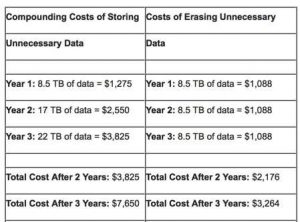Storage vs. Data Erasure ROI Calculator From Blancco
Free online tool lets companies see impact of erasing data on storage costs
This is a Press Release edited by StorageNewsletter.com on July 5, 2017 at 2:52 pmCompanies spend an average of $1,593 per raw terabyte of capacity on storage costs each year, according to Gartner, Inc.
These costs include annual operational expense, lease, depreciation, maintenance, installation and taxes, as well as hardware, software, connectivity, DR, occupancy and personnel.
But only 15% of the average company’s data is business-critical, which leaves 85% that is classified as ROT (redundant, obsolete or trivial) and dark data that could be erased.
Blancco Technology Group has launched its Storage vs. Data Erasure ROI Calculator to help companies visualize just how much money they could save by erasing unneeded data.
The ROI calculator processes the average amount of data companies create and store, using a general hard cost average of $150 per terabyte of cloud storage. It then provides a side-by-side view of the average cost of storing data and the average cost of erasing data. The tool shows the cost savings delivered over time and includes a total cost savings that could be achieved after three years of implementing data erasure processes.
When 85% of the data stored by companies is deemed unnecessary and there are no data erasure processes in place, the costs of storing data compound over time. But when companies implement data erasure processes, their storage costs will decrease over time. On top of these cost savings, data erasure reduces the quantity of data that could potentially be exposed to data loss/theft in the event of a data breach.
Below is an example of the math behind the savings for a company adding as 10TB of data each year. The assumption is that 85% of that data, or 8.5TB, is not business-critical and should be erased each year.

Richard Stiennon, chief strategy officer, Blancco (and former Gartner analyst), says this tool provides an important first step for IT security executives and CIOs looking to reduce their storage costs. “It’s one thing to hear about the mitigated security risks and compliance other organizations have achieved through data erasure. But it’s much more compelling when companies can see the impact data erasure can have on their storage costs compounded over time. Suddenly, data erasure becomes a critical data security solution that not only minimizes exposure to data loss/theft and ensures regulatory compliance, but also delivers a better bottom line.“
As companies look for ways to manage their storage budgets, the following steps will enable them to achieve cost savings and a security posture on a long-term basis:
-
Create a data lifecycle management strategy
-
Classify data types and determine the length of time required to store the data
-
Know your storage budget, including soft and hidden costs
-
Determine where you can save money by erasing unneeded data, instead of storing it
-
Create processes for classifying and erasing unneeded data
-
Evaluate data management processes on an ongoing basis based on new technologies and changes within the organization












 Subscribe to our free daily newsletter
Subscribe to our free daily newsletter
